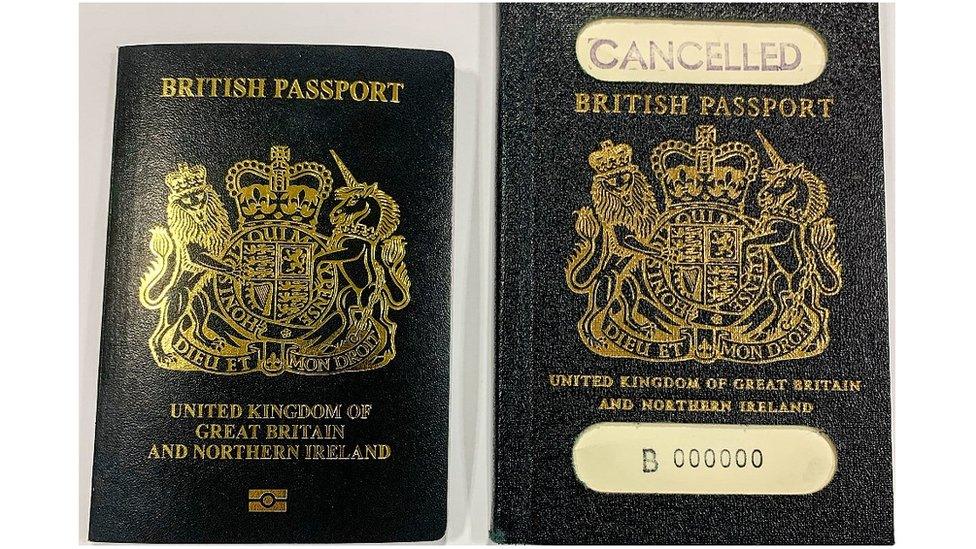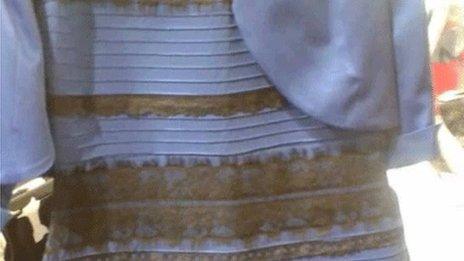Is the new passport really blue or black?
- Published

The new passport (left) is a return to the "iconic blue" of the old one, the Home Office says
Is the new UK passport blue? Or is the colour really closer to black?
The Home Office has issued pictures of the post-Brexit passport, describing it as a return to the "iconic blue" used for UK passports before 1988.
Experts in the science of colour - and instant experts on social media - are unconvinced, saying they look more like black.
But a Home Office spokesman says the colours of both the old and new passports are shades of blue.
"I'd say it's black," says Stephen Westland, professor of colour science and technology at the University of Leeds.
Allow X content?
This article contains content provided by X. We ask for your permission before anything is loaded, as they may be using cookies and other technologies. You may want to read X’s cookie policy, external and privacy policy, external before accepting. To view this content choose ‘accept and continue’.

"If most people looked at this, they'd say it's black."
But he says describing colours in terms of names can be imprecise - and individuals will have their own different perspectives.
If enough blue is added to black, he says there will be a transition point when people will begin to see the colour as blue.
"But that point varies for different people," he says.
That means that some might see a colour as an extremely dark shade of blue, while others would see it as black.
Perhaps allowing the Home Office not to be entirely painted into a corner, he suggests the colour might be "bluish black".
But in essence, Prof Westland says, "this is closer to black".
Allow X content?
This article contains content provided by X. We ask for your permission before anything is loaded, as they may be using cookies and other technologies. You may want to read X’s cookie policy, external and privacy policy, external before accepting. To view this content choose ‘accept and continue’.

However he says the perception of colour can be influenced by its context - and by calling it a "blue passport" people might be more likely to see it as leaning towards blue.
Replacing the burgundy-coloured European Union document, the new UK passport has been described as a return to the "traditional colour".
Allow X content?
This article contains content provided by X. We ask for your permission before anything is loaded, as they may be using cookies and other technologies. You may want to read X’s cookie policy, external and privacy policy, external before accepting. To view this content choose ‘accept and continue’.

Home Secretary Priti Patel has said the return to this "iconic blue" was "entwined with our national identity and I cannot wait to travel on one".
The Home Office would not specify the shade of this blue, although a spokesman said it was close to, if not exactly, a blue numbered as 5395C in the Pantone classification.
Allow X content?
This article contains content provided by X. We ask for your permission before anything is loaded, as they may be using cookies and other technologies. You may want to read X’s cookie policy, external and privacy policy, external before accepting. To view this content choose ‘accept and continue’.

But Craig Burston, senior lecturer in graphic design at the London College of Communication, which incorporates what was the London College of Printing, says there is nothing to suggest the "dominant colour" of the new passport is blue.
He suggests the colour is charcoal, maybe with a hint of blue.
But if it is blue, "it must be the most apologetic shade of blue they could find" because "it's as black as blue gets".
"You'd be hard pushed to get something that is darker that would be defined as blue," Mr Burston says.
"It's as near as damn it black."
Allow X content?
This article contains content provided by X. We ask for your permission before anything is loaded, as they may be using cookies and other technologies. You may want to read X’s cookie policy, external and privacy policy, external before accepting. To view this content choose ‘accept and continue’.

There could be differences depending on printing processes, lighting and the "sheen", he says.
But the question of the colour seems to have been mixed up with the politics of "blue passports".
And the social-media debate seems to be about Brexit as much as colour charts.
A spokesman for paint company Farrow and Ball says "pure" black would have no other colours added.
But in practice, blacks used in the "everyday world would have a slight colour to them", such as blue, grey or red.
This could make the passport a very dark blue although "some people may perceive it as black".
It is "probably black blue," said the paint firm's spokesman.
There have been other internet debates over identifying colours - such as whether a dress was blue or white and gold.
Prof Westland says this reflects how people tend to see colours in quite definite ways, coming down on one side or the other, even though we know there are all kinds of shades and ambiguities.
"People tend to make a decision about colours," he says.
- Published22 February 2020

- Published27 February 2015

- Published6 April 2019
